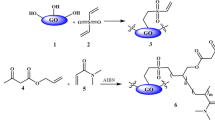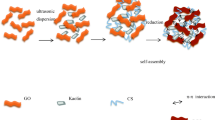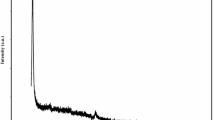Abstract
A novel tannic acid–reduced graphene oxide (TAG) composite absorbent was prepared by using a simple one-step method. The prepared TAG was characterized by various analytical techniques including FTIR, Brunauer–Emmett–Teller (BET), scanning electron microscopy, X-ray diffraction, and X-ray photoelectron spectroscopy. Tannic acid (TA) not only can prevent graphene sheets from agglomerating by suppressing the hydrophobic stacking interactions but also can introduce a large number of phenol hydroxyls. The adsorption studies indicate that the TAG composite showed an excellent uptake capacity (179.22 mg/g) for Cr(VI) under the optimized conditions (viz., adsorbent dosages of 0.75 g/L, solution pH of 2.5, contact time of 360 min, and temperature of 60 °C), which is higher than that of most graphene oxide– and TA-based adsorbents. The BET specific surface area of TAG was calculated to be 118.3 m2/g; the pore diameter of Tannin acid-reduced graphene hydrogel (TAGH) was mainly 3–6 nm, with pore size peak at 5.0 nm. The kinetics of Cr(VI) adsorption on TAG followed the pseudo-second-order model. The isotherm studies confirmed that the Cr(VI) chemically adsorbed on TAG in a monolayer fashion, which was attributed to the electrostatic interaction between chromium ions and oxygen negative ions. The process of Cr(VI) adsorption was found to be thermodynamically spontaneous and endothermic.











Similar content being viewed by others
References
Shen H, Chen J, Dai H, Wang L, Hu M, Xia Q (2013) New insights into the sorption and detoxification of chromium(VI) by tetraethylenepentamine functionalized nanosized magnetic polymer adsorbents: mechanism and pH effect. Ind Eng Chem Res 52(36):12723–12732. https://doi.org/10.1021/ie4010805
Zhao Y, Zhao D, Chen C, Wang X (2013) Enhanced photo-reduction and removal of Cr(VI) on reduced graphene oxide decorated with TiO2 nanoparticles. J Colloid Interface Sci 405:211–217. https://doi.org/10.1016/j.jcis.2013.05.004
Basha S, Murthy ZVP (2007) Kinetic and equilibrium models for biosorption of Cr(VI) on chemically modified seaweed, Cystoseira indica. Process Biochem 42(11):1521–1529. https://doi.org/10.1016/j.procbio.2007.08.004
Zou Y, Wang X, Khan A, Wang P, Liu Y, Alsaedi A, Hayat T, Wang X (2016) Environmental remediation and application of nanoscale zero-valent iron and its composites for the removal of heavy metal ions: a review. Environ Sci Technol 50(14):7290–7304. https://doi.org/10.1021/acs.est.6b01897
Zolgharnein J, Shahmoradi A (2010) Adsorption of Cr(VI) onto Elaeagnus tree leaves: statistical optimization, equilibrium modeling, and kinetic studies. J Chem Eng Data 55(9):3428–3437. https://doi.org/10.1021/je100157y
Bai X, Du Y, Hu X, He Y, He C, Liu E, Fan J (2018) Synergy removal of Cr (VI) and organic pollutants over RP-MoS2/rGO photocatalyst. Appl Catal B Environ 239:204–213. https://doi.org/10.1016/j.apcatb.2018.08.016
Ghosh S, Remita H, Basu RN (2018) Visible-light-induced reduction of Cr(VI) by PDPB-ZnO nanohybrids and its photo-electrochemical response. Appl Catal B Environ 239:362–372. https://doi.org/10.1016/j.apcatb.2018.08.034
Du X-D, Yi X-H, Wang P, Zheng W, Deng J, Wang C-C (2019) Robust photocatalytic reduction of Cr(VI) on UiO-66-NH2(Zr/Hf) metal-organic framework membrane under sunlight irradiation. Chem Eng J 356:393–399. https://doi.org/10.1016/j.cej.2018.09.084
Luo X, Wang C, Wang L, Deng F, Luo S, Tu X, Au C (2013) Nanocomposites of graphene oxide-hydrated zirconium oxide for simultaneous removal of As(III) and As(V) from water. Chem Eng J 220:98–106. https://doi.org/10.1016/j.cej.2013.01.017
Qiu B, Wang Y, Sun D, Wang Q, Zhang X, Weeks BL, O'Connor R, Huang X, Wei S, Guo Z (2015) Cr(VI) removal by magnetic carbon nanocomposites derived from cellulose at different carbonization temperatures. J Mater Chem A 3(18):9817–9825. https://doi.org/10.1039/c5ta01227a
Niazi L, Lashanizadegan A, Sharififard H (2018) Chestnut oak shells activated carbon: preparation, characterization and application for Cr (VI) removal from dilute aqueous solutions. J Clean Prod 185:554–561. https://doi.org/10.1016/j.jclepro.2018.03.026
Nair RR, Blake P, Grigorenko AN, Novoselov KS, Booth TJ, Stauber T, Peres NM, Geim AK (2008) Fine structure constant defines visual transparency of graphene. Science 320(5881):1308. https://doi.org/10.1126/science.1156965
Chauke VP, Maity A, Chetty A (2015) High-performance towards removal of toxic hexavalent chromium from aqueous solution using graphene oxide-alpha cyclodextrin-polypyrrole nanocomposites. J Mol Liq 211:71–77. https://doi.org/10.1016/j.molliq.2015.06.044
Zhang B, Hu R, Sun D, Wu T, Li Y (2018) Fabrication of chitosan/magnetite-graphene oxide composites as a novel bioadsorbent for adsorption and detoxification of Cr(VI) from aqueous solution. Sci Rep 8(1):15397. https://doi.org/10.1038/s41598-018-33925-7
Chen D, Zhang H, Yang K, Wang H (2016) Functionalization of 4-aminothiophenol and 3-aminopropyltriethoxysilane with graphene oxide for potential dye and copper removal. J Hazard Mater 310:179–187. https://doi.org/10.1016/j.jhazmat.2016.02.040
Madadrang CJ, Kim HY, Gao G, Wang N, Zhu J, Feng H, Gorring M, Kasner ML, Hou S (2012) Adsorption behavior of EDTA-graphene oxide for Pb (II) removal. ACS Appl Mater Interfaces 4(3):1186–1193. https://doi.org/10.1021/am201645g
Qi Y, Yang M, Xu W, He S, Men Y (2017) Natural polysaccharides-modified graphene oxide for adsorption of organic dyes from aqueous solutions. J Colloid Interface Sci 486:84–96. https://doi.org/10.1016/j.jcis.2016.09.058
Wu Z, Zhong H, Yuan X, Wang H, Wang L, Chen X, Zeng G, Wu Y (2014) Adsorptive removal of methylene blue by rhamnolipid-functionalized graphene oxide from wastewater. Water Res 67:330–344. https://doi.org/10.1016/j.watres.2014.09.026
Wang Z, Lin F, Huang L, Chang Z, Yang B, Liu S, Zheng M, Lu Y, Chen J (2019) Cyclodextrin functionalized 3D-graphene for the removal of Cr(VI) with the easy and rapid separation strategy. Environ Pollut 254. https://doi.org/10.1016/j.envpol.2019.07.022
Bi H, Xie X, Yin K, Zhou Y, Wan S, He L, Xu F, Banhart F, Sun L, Ruoff RS (2012) Spongy graphene as a highly efficient and recyclable sorbent for oils and organic solvents. Adv Funct Mater 22(21):4421–4425. https://doi.org/10.1002/adfm.201200888
Song X, Chen Y, Rong M, Xie Z, Zhao T, Wang Y, Chen X, Wolfbeis OS (2016) A phytic acid induced super-amphiphilic multifunctional 3D graphene-based foam. Angew Chem 55(12):3936–3941. https://doi.org/10.1002/anie.201511064
Lu K-Q, Yuan L, Xin X, Xu Y-J (2018) Hybridization of graphene oxide with commercial graphene for constructing 3D metal-free aerogel with enhanced photocatalysis. Appl Catal B Environ 226:16–22. https://doi.org/10.1016/j.apcatb.2017.12.032
Chen Y, Chen L, Bai H, Li L (2013) Graphene oxide–chitosan composite hydrogels as broad-spectrum adsorbents for water purification. J Mater Chem A 1(6):1992–2001. https://doi.org/10.1039/c2ta00406b
Cong HP, Qiu JH, Yu SH (2015) Thermoresponsive poly(N-isopropylacrylamide)/graphene/Au nanocomposite hydrogel for water treatment by a laser-assisted approach. Small 11(9–10):1165–1170. https://doi.org/10.1002/smll.201401651
Gan L, Shang S, Hu E, Yuen CWM, S-x J (2015) Konjac glucomannan/graphene oxide hydrogel with enhanced dyes adsorption capability for methyl blue and methyl orange. Appl Surf Sci 357:866–872. https://doi.org/10.1016/j.apsusc.2015.09.106
Gao H, Sun Y, Zhou J, Xu R, Duan H (2013) Mussel-inspired synthesis of polydopamine-functionalized graphene hydrogel as reusable adsorbents for water purification. ACS Appl Mater Interfaces 5(2):425–432. https://doi.org/10.1021/am302500v
Tiwari JN, Mahesh K, Le NH, Kemp KC, Timilsina R, Tiwari RN, Kim KS (2013) Reduced graphene oxide-based hydrogels for the efficient capture of dye pollutants from aqueous solutions. Carbon 56:173–182. https://doi.org/10.1016/j.carbon.2013.01.001
Varaprasad K, Jayaramudu T, Sadiku ER (2017) Removal of dye by carboxymethyl cellulose, acrylamide and graphene oxide via a free radical polymerization process. Carbohydr Polym 164:186–194. https://doi.org/10.1016/j.carbpol.2017.01.094
Hagerman AE, Riedl KM, Jones GA, Sovik KN, Ritchard NT, Hartzfeld PW, Riechel TL (1998) High molecular weight plant polyphenolics (tannins) as biological antioxidants. J Agric Food Chem 46(5):1887–1892
Huang X, Wu H, Liao X, Shi B (2010) One-step, size-controlled synthesis of gold nanoparticles at room temperature using plant tannin. Green Chem 12(3):395–399. https://doi.org/10.1039/b918176h
Mohamed AK, Mahmoud ME (2020) Nanoscale Pisum sativum pods biochar encapsulated starch hydrogel: a novel nanosorbent for efficient chromium (VI) ions and naproxen drug removal. Bioresour Technol 308. https://doi.org/10.1016/j.biortech.2020.123263
Mahmoud ME, Osman MM, Abdel-Aal H, Nabil GM (2020) Microwave-assisted adsorption of Cr(VI), Cd(II) and Pb(II) in presence of magnetic graphene oxide-covalently functionalized-tryptophan nanocomposite. J Alloys Compd:823. https://doi.org/10.1016/j.jallcom.2020.153855
Mahmoud ME, Amira MF, Seleim SM, Mohamed AK (2020) Amino-decorated magnetic metal-organic framework as a potential novel platform for selective removal of chromium (VI), cadmium (II) and lead (II). J Hazard Mater 381. https://doi.org/10.1016/j.jhazmat.2019.120979
Mahmoud ME, Abdou AEH, Sobhy ME (2017) Engineered nano-zirconium oxide-crosslinked-nanolayer of carboxymethyl cellulose for speciation and adsorptive removal of Cr(III) and Cr(VI). Powder Technol 321:444–453. https://doi.org/10.1016/j.powtec.2017.08.041
Mahmoud ME, Yakout AA, Abdel-Aal H, Osman MM (2015) Speciation and selective biosorption of Cr(III) and Cr(VI) using nanosilica immobilized-fungi biosorbents. J Environ Eng 141(4):04014079. https://doi.org/10.1061/(asce)ee.1943-7870.0000899
Hummers WS Jr, Offeman RE (1958) Preparation of graphitic oxide. J Am Chem Soc 80(6):1339–1339
Luo J, Lai J, Zhang N, Liu Y, Liu R, Liu X (2016) Tannic acid induced self-assembly of three-dimensional graphene with good adsorption and antibacterial properties. ACS Sustain Chem Eng 4(3):1404–1413. https://doi.org/10.1021/acssuschemeng.5b01407
Lim M-Y, Shin H, Shin DM, Lee S-S, Lee J-C (2016) Poly(vinyl alcohol) nanocomposites containing reduced graphene oxide coated with tannic acid for humidity sensor. Polymer 84:89–98. https://doi.org/10.1016/j.polymer.2015.12.048
Ji CC, Xu MW, Bao SJ, Cai CJ, Lu ZJ, Chai H, Yang F, Wei H (2013) Self-assembly of three-dimensional interconnected graphene-based aerogels and its application in supercapacitors. J Colloid Interface Sci 407:416–424. https://doi.org/10.1016/j.jcis.2013.06.054
Ma Z, Zhao X, Gong C, Zhang J, Zhang J, Gu X, Tong L, Zhou J, Zhang Z (2015) Preparation of a graphene-based composite aerogel and the effects of carbon nanotubes on preserving the porous structure of the aerogel and improving its capacitor performance. J Mater Chem A 3(25):13445–13452
Luo J, Zhong W, Zou Y, Xiong C, Yang W (2016) Preparation of morphology-controllable polyaniline and polyaniline/graphene hydrogels for high performance binder-free supercapacitor electrodes. J Power Sources 319:73–81. https://doi.org/10.1016/j.jpowsour.2016.04.004
Lei Y, Tang Z, Liao R, Guo B (2011) Hydrolysable tannin as environmentally friendly reducer and stabilizer for graphene oxide. Green Chem 13(7):1655. https://doi.org/10.1039/c1gc15081b
Xiong C, Zou Y, Peng Z, Zhong W (2019) Synthesis of morphology-tunable electroactive biomass/graphene composites using metal ions for supercapacitors. Nanoscale 11(15):7304–7316. https://doi.org/10.1039/c9nr00659a
Tang CY, Yu P, Tang LS, Wang QY, Bao RY, Liu ZY, Yang MB, Yang W (2018) Tannic acid functionalized graphene hydrogel for organic dye adsorption. Ecotoxicol Environ Saf 165:299–306. https://doi.org/10.1016/j.ecoenv.2018.09.009
Xu Y, Sheng K, Li C, Shi G (2010) Self-assembled graphene hydrogel via a one-step hydrothermal process. ACS Nano 4(7):4324–4330
Milczarek G, Inganäs O (2012) Renewable cathode materials from biopolymer/conjugated polymer interpenetrating networks. Science 335(6075):1468–1471
Kim SK, Kim YK, Lee H, Lee SB, Park HS (2014) Superior pseudocapacitive behavior of confined lignin nanocrystals for renewable energy-storage materials. ChemSusChem 7(4):1094–1101. https://doi.org/10.1002/cssc.201301061
Monser L, Adhoum N (2009) Tartrazine modified activated carbon for the removal of Pb(II), Cd(II) and Cr(III). J Hazard Mater 161(1):263–269. https://doi.org/10.1016/j.jhazmat.2008.03.120
Huang G, Shi JX, Langrish TAG (2009) Removal of Cr(VI) from aqueous solution using activated carbon modified with nitric acid. Chem Eng J 152(2–3):434–439. https://doi.org/10.1016/j.cej.2009.05.003
Li W, Gong X, Li X, Zhang D, Gong H (2012) Removal of Cr(VI) from low-temperature micro-polluted surface water by tannic acid immobilized powdered activated carbon. Bioresour Technol 113:106–113. https://doi.org/10.1016/j.biortech.2011.12.037
Chand R, Narimura K, Kawakita H, Ohto K, Watari T, Inoue K (2009) Grape waste as a biosorbent for removing Cr(VI) from aqueous solution. J Hazard Mater 163(1):245–250. https://doi.org/10.1016/j.jhazmat.2008.06.084
Bishnoi NR, Bajaj M, Sharma N, Gupta A (2004) Adsorption of Cr(VI) on activated rice husk carbon and activated alumina. Bioresour Technol 91(3):305–307. https://doi.org/10.1016/s0960-8524(03)00204-9
Plazinski W, Rudzinski W, Plazinska A (2009) Theoretical models of sorption kinetics including a surface reaction mechanism: a review. Adv Colloid Interf Sci 152(1–2):2–13. https://doi.org/10.1016/j.cis.2009.07.009
Fan L, Zhang Y, Luo C, Lu F, Qiu H, Sun M (2012) Synthesis and characterization of magnetic beta-cyclodextrin-chitosan nanoparticles as nano-adsorbents for removal of methyl blue. Int J Biol Macromol 50(2):444–450. https://doi.org/10.1016/j.ijbiomac.2011.12.016
Kumar KV (2007) Pseudo-second order models for the adsorption of safranin onto activated carbon: comparison of linear and non-linear regression methods. J Hazard Mater 142(1–2):564–567. https://doi.org/10.1016/j.jhazmat.2006.08.018
Hubbe MA, Rojas OJ, Lucia LA (2015) Green modification of surface characteristics of cellulosic materials at the molecular or nano scale: a review. Bioresources 10(3):6095–6206
Langmuir I (1918) The adsorption of gases on plane surfaces of glass, mica and platinum. J Am Chem Soc 40(9):1361–1403
Nouri L, Ghodbane I, Hamdaoui O, Chiha M (2007) Batch sorption dynamics and equilibrium for the removal of cadmium ions from aqueous phase using wheat bran. J Hazard Mater 149(1):115–125. https://doi.org/10.1016/j.jhazmat.2007.03.055
Hu X-j, Wang J-s, Y-g L, Li X, G-m Z, Bao Z-l, X-x Z, A-w C, Long F (2011) Adsorption of chromium (VI) by ethylenediamine-modified cross-linked magnetic chitosan resin: isotherms, kinetics and thermodynamics. J Hazard Mater 185(1):306–314. https://doi.org/10.1016/j.jhazmat.2010.09.034
Bhattacharya A, Naiya T, Mandal S, Das S (2007) Adsorption, kinetics and equilibrium studies on removal of Cr(VI) from aqueous solutions using different low-cost adsorbents. Chem Eng J. https://doi.org/10.1016/j.cej.2007.05.021
Li L, Fan L, Sun M, Qiu H, Li X, Duan H, Luo C (2013) Adsorbent for chromium removal based on graphene oxide functionalized with magnetic cyclodextrin-chitosan. Colloids Surf B Biointerfaces 107:76–83. https://doi.org/10.1016/j.colsurfb.2013.01.074
Liu M, Xu J, Cheng B, Ho W, Yu J (2015) Synthesis and adsorption performance of Mg(OH)2 hexagonal nanosheet–graphene oxide composites. Appl Surf Sci 332:121–129. https://doi.org/10.1016/j.apsusc.2015.01.121
M-r S, Y-g L, S-b L, G-m Z, Tan X-f, L-h J, X-x H, Ding Y, Guo Y-m, Wang S-f (2016) A novel graphene oxide coated biochar composite: synthesis, characterization and application for Cr (VI) removal. RSC Adv 6(88):85202–85212
Author information
Authors and Affiliations
Corresponding author
Additional information
Publisher’s Note
Springer Nature remains neutral with regard to jurisdictional claims in published maps and institutional affiliations.
Rights and permissions
About this article
Cite this article
Cheng, C., Jia, M., Cui, L. et al. Adsorption of Cr(VI) ion on tannic acid/graphene oxide composite aerogel: kinetics, equilibrium, and thermodynamics studies. Biomass Conv. Bioref. 12, 3875–3885 (2022). https://doi.org/10.1007/s13399-020-00899-4
Received:
Revised:
Accepted:
Published:
Issue Date:
DOI: https://doi.org/10.1007/s13399-020-00899-4




